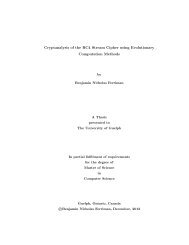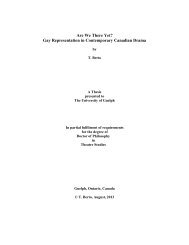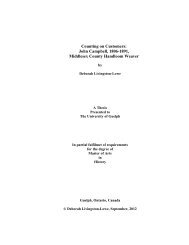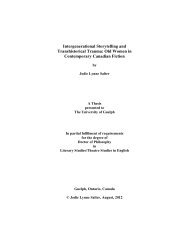THESIS - ROC CH ... - FINAL - resubmission.pdf - University of Guelph
THESIS - ROC CH ... - FINAL - resubmission.pdf - University of Guelph
THESIS - ROC CH ... - FINAL - resubmission.pdf - University of Guelph
Create successful ePaper yourself
Turn your PDF publications into a flip-book with our unique Google optimized e-Paper software.
5.3.3 WIDE ANGLE X-RAY DIFFRACTION (WAXD) ANALYSIS<br />
WAXD studies <strong>of</strong> freeze dried cellulose specimens were carried out using a radiation<br />
source from CuKα1 (λ = 1.54 Å) with operational settings at 40 kV and 40 mA (Rigaku Powder<br />
Diffractometer equipment – Rigaku Co., Tokyo, Japan). The diffractometer had a 0.5°<br />
divergence slit, a 0.33 mm receiving slit, and a 0.5° scattering slit. The samples were scanned<br />
from 5° to 45° (2θ) at 0.5°/min. Using the following equation from Segal’s method (Segal et al.<br />
1959), the crystallinity index (CI) was calculated from the heights <strong>of</strong> the 2 0 0 peak (I200, 2θ =<br />
22.6°) and the intensity minimum between 2 0 0 and 1 1 0 peaks (Iam, 2θ =18°).<br />
( ) (<br />
I200 is the maximum intensity (arbitrary units) corresponding to cellulose I, whereas Iam<br />
represents the amorphous material.<br />
5.3.4 FTIR Analysis<br />
FTIR analysis was performed as described in Section 4.3.8<br />
5.4 RESULTS AND DISCUSSION<br />
5.4.1 VISUAL OBSERVATIONS<br />
The physical appearance <strong>of</strong> the cellulose fibers through the main steps <strong>of</strong> the extraction<br />
process can be seen in Figure 5.1. Two types <strong>of</strong> fibers were observed and retained from the<br />
50<br />
)

















